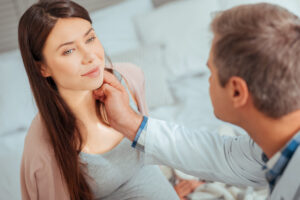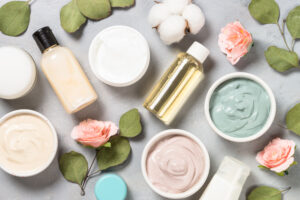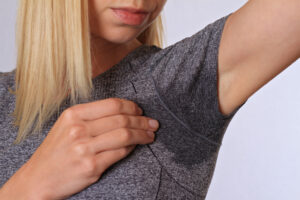 Food allergies affect over 200 million people worldwide, but food sensitivities affect a much higher number, making both a public health concern. Once women reach the age bracket of 13 to 21, they are significantly prone to and diagnosed with food sensitivities. As we continue to age, our immune and digestive systems don’t function as well as in our youth. Other internal, external, and environmental factors like stress, psychological factors, IBS, sensitivity to food additives and more may have something to do with food-related sensitivities.
Food allergies affect over 200 million people worldwide, but food sensitivities affect a much higher number, making both a public health concern. Once women reach the age bracket of 13 to 21, they are significantly prone to and diagnosed with food sensitivities. As we continue to age, our immune and digestive systems don’t function as well as in our youth. Other internal, external, and environmental factors like stress, psychological factors, IBS, sensitivity to food additives and more may have something to do with food-related sensitivities.
Difference of Allergies and Sensitivities
To differentiate, food allergies typically are symptomatically like anaphylaxis, cause skin rashes, and in some cases can be life threatening. Food sensitivities, however, are comparatively less serious and limited to digestive issues.
How to Address Them: Understanding Them
While we can’t control our bodies in every way as we age, here are some precautions we can take and common issues that will help us recognize an issue when it begins.
- Lack of Enzymes: the enzymes needed to fully digest food begin to decrease as we grow older. For example, lactose intolerance is due to a decrease in lactase, a digestive enzyme that breaks down lactose. Lactase production naturally decreases as we age, so what you can do to supplement that is consistently consuming dairy products to prevent deficiency.
- Additives/Food Dyes: sensitivity to food additives can worsen as we age. Food dyes and colorings, antioxidants, flavorings, and preservatives are the most common instigators. The FDA allows more additives than other countries and, as we are more and more exposed to them, reactions can happen with age. Skin reactions, gastrointestinal issues and respiratory symptoms are the most common physical responses. It’s always best to read food labels carefully and keep a food diary if new symptoms arise.
- Stress: Many sensitivities that arise in women aged 28 and older are stress-related. There are different personal ways each one of us uses to relax, and therapy is always a helpful resource if you find your stress levels are not reducing.
- Premenstrual Syndrome: A small study found a connection between lactose intolerance and premenstrual syndrome (PMS), as well as mental depression especially in females. Their prevalent theory is that high concentrations of lactose interfere with tryptophan and serotonin metabolism, which are crucial for mood control.
While we can’t control everything that goes on around and in our bodies, we can be aware of what helps, what signals a developing issue, and the preventative methods we can take as we grow older and wiser. Always consult your doctor if you have any questions, unexplained symptoms, or concerns.
More
By Iris Farrou
09 Sep, 2021
Diet & Exercise
Best gyns in Buffalo, Best OB practices in Buffalo, Best OBGYN Groups in Buffalo, Buffalo OB-GYN, Buffalo OBGYN, Chouchani MD, WNY OB-GYN, WNY Ob-gyn doctors, WNY OBGYN, women's health, women's health tips
 Swimming is a wonderful way to exercise, relieve stress, practice less strenuous physical therapy, and many other benefits. Especially in the summer, we use swimming not only as a way to cool down, but also as the primary relaxation technique. After all, what is summertime without imagining ourselves by a pool or by the ocean?
Swimming is a wonderful way to exercise, relieve stress, practice less strenuous physical therapy, and many other benefits. Especially in the summer, we use swimming not only as a way to cool down, but also as the primary relaxation technique. After all, what is summertime without imagining ourselves by a pool or by the ocean?
We are already deep into the summer season, so our bodies have most likely been deep into pools, fresh water, or the sea. Along with the many positive effects that swimming can have on our physical and mental health, there are some elements that pose a threat to female hygiene and vaginal health: the widely dreaded yeast infections.
How are they caused?
Yeast infections are, essentially, fungal infections that cause irritation and discharge, as well as extreme itchiness. They thrive in conditions that help fungi develop: water with bacteria, or water with chemicals, as well as lounging in our swimsuits after swimming—innocently drying off in the sun while giving bacteria ample space to thrive.
How do we prevent them?
Currently over 138 million women suffer from recurrent candid, another name for yeast infections, so sound advice and safe habits can go a long way in preventing swim-induced infections.
- Immediately rinse off in a shower after swimming and change into dry swimsuit bottoms or fresh underwear. This drastically reduces the risk of bacterial development.
- Wash your swimwear when you get home. Use dye-free or sensitive laundry detergent, or if unavailable, rinse thoroughly with fresh water for several minutes. Hang your swimsuit up to dry completely before using it again.
- Reduce or eliminate your exposure to chlorinated water, especially in a hot water environment like a hot tub. This is a more drastic measure meant for those of us who are very prone to UTIs and candida, are pregnant, on antibiotic or certain medications, have diabetes, or a weakened immune system that may lead to yeast infections developing more easily.
- Keep your body hydrated with clean drinking water to assist your bladder in flushing out the bad bacteria and keeping the good bacteria. Remember that the female vagina is almost like a self-cleaning oven, and you can assist it in keeping itself healthy. Eating probiotic foods or taking liquid probiotic supplements, as well as reducing our intake of alcohol and sugary foods can also fortify vaginal pH balance.
What are some symptoms?
- If you experience increased frequent need to urinate, painful urination, chills, burning urination or even lower back aches, you may have developed a urinary tract infection as well.
- Increased discharge that potentially smells stronger and is gray colored, along with vaginal itching, tenderness and/or swelling are all signs of yeast infections.
As always, pay attention to what your body is feeling and doing. If something doesn’t feel, look or act normal down there, contact your gynecologist or general practitioner immediately. Yeast infections and UTIs are nothing to be embarrassed about, and important to address quickly for physical and mental wellness.
More
By Iris Farrou
27 Aug, 2021
Women's Health
Best gyns in Buffalo, Best OB practices in Buffalo, Best OBGYN Groups in Buffalo, Buffalo OB-GYN, Buffalo OBGYN, Chouchani MD, WNY OB-GYN, WNY Ob-gyn doctors, WNY OBGYN, women's health, women's health tips

Back pain during pregnancy is one of the most common causes of pain and discomfort. In later pregnancy, the pain can lead to insomnia, fatigue, and women opting for early birth inductions. While many medical professionals and journals label back pain during pregnancy as a “minor” symptom, anyone who has experienced it will tell you that is an understatement.
If you’ve never heard of an Ozzlo Pillow, it’s a wedge-shaped pillow designed to prevent or alleviate both back-aches and back-ache induced insomnia. The wedge pillow is placed under the abdomen while laying on your side, providing great support and relief. An overwhelming 87% of women experience back pain in the last few weeks of gestation. Medical studies found that wedge-shaped pillows do indeed dramatically reduce pain and allow for a better night’s rest. Even using a regular pillow in the same placement can be almost as effective.
Aside from medical studies with the wedge pillow, here’s a list of tried and tested different support pillows that can make pregnancy an even better experience:
- U-Shaped body pillows rank first among most pregnant women, who praise their size and shape-adapting ability, reporting that they relieve most of the pain they feel and reduce discomfort. There are even some U-Shaped body pillows designed specifically for pregnancy with a special space for abdominal placement.
- Memory Foam Body Pillows also do wonders for forming to parts of your body, providing support and pressure relief. This is a slightly more cost-effective option that provides the same level of pain alleviation as other—more specialized and expensive—orthopedic pillows.
- Yana Pillows are similar to U-Shape Pregnancy pillows and have a special filling that provides luxurious relief for both back and side-sleeping pregnant women. It shapes itself on the curves of the body, so when using it your body does not have to inconvenience itself. Rather, the pillow adjusts to provide the support you need and relieve you from the aches of pregnancy.
- The Belly-Bandit is a 3-piece and OB-GYN-designed pillow, best for helping pregnant women sleep on their side to achieve optimal blood flow and oxygen to their baby. As it is a more versatile pillow, its great advantage is that it can be used by women prior to pregnancy so that they get accustomed to sleeping on their sides.
The advantages of pregnancy/orthopedic pillows go beyond pain alleviation: relieving the pain is great, but these pillows also prevent the use of pain relievers, reduce heartburn, avoid orthopedic medical intervention in the long run, prevent postnatal back and sciatic nerve issues, and reduce stress levels. Feel free to consult your doctor if you’re unsure which support pillow would best fit your needs, as you may need different support during the different stages of pregnancy.
More
By Iris Farrou
19 Aug, 2021
Pregnancy
Best gyns in Buffalo, Best OB practices in Buffalo, Best OBGYN Groups in Buffalo, Buffalo OB-GYN, Buffalo OBGYN, Chouchani MD, Healthy pregnancy, WNY OB-GYN, WNY Ob-gyn doctors, WNY OBGYN, women's health, women's health tips
 Mosquitos are an inevitable annoyance during the warmer months for most of us. If you’re pregnant, you’re probably already overwhelmed with all the dangers you’re advised to avoid and adding to this list is now mosquito repellents. Same goes for people with sensitive skin, who are between a rock and a hard place in choosing a mosquito repellent that will not irritate their skin and having to deal with mosquito bites until this is achieved.
Mosquitos are an inevitable annoyance during the warmer months for most of us. If you’re pregnant, you’re probably already overwhelmed with all the dangers you’re advised to avoid and adding to this list is now mosquito repellents. Same goes for people with sensitive skin, who are between a rock and a hard place in choosing a mosquito repellent that will not irritate their skin and having to deal with mosquito bites until this is achieved.
What is the main danger?
While Deet, the nickname of the chemical insecticide “N, N-diethl-meta-toluamide” or diethyltoluamide, has been found to be both safe for humans and effective in protecting against mosquito-borne illnesses in does not cease to be a chemical. As such, it should always be used in moderation and it is likely to annoy your skin, especially if you are rather sensitive.
However, the consensus seems to be that it is safe to use mosquito repellents containing Deet while pregnant. Studies are still ongoing as to the exact effects/risks of mosquito repellents on pregnancies, but moderation is key when we don’t have all the answers.
How can women avoid dangerous chemicals, skin reactions, and pesky bug bites?
- Wear lightweight clothes that cover as much skin as possible; for the exposed parts of your body, try an all-natural insect repellent.
- Sandals are not a good idea, as many mosquitoes are attracted to the smell of feet—this is due to their olfactory preferences. Wear socks or long pants that you can tuck into your shoes to prevent bites on your feet.
- Burn citronella candles and/or incense. Also, ask your pharmacist or natural medicine professionals which essential oils are safe to use while pregnant or for your specific body to ward off unwanted bites.
- Wear loose clothing, and not Spandex: mosquitoes bite right through that! You may also want to consider spraying your clothes with repellents, and not your skin. In this manner, you avoid direct contact with potentially harmful chemicals.
- Avoid immersing yourself in deep-wooded areas, or in areas where a lot of vegetation grows. Mosquitoes are attracted to moisture and standing water, or watery areas that are not regularly cleaned.
- If possible, screen your windows and/or porches at your home. That way you can enjoy summer without being attacked by mosquitoes.
- If you’re traveling to an area where there are high risks of insect-borne diseases like Malaria, Zika or West Nile Virus, the potential risks of using Deet can sometimes outweigh those of the viruses. If using repellents with Deet is your best option, they should be used very sparingly. Anti-malarial medications like Doxycycline may also be prescribed.
As always, consult your gynecologist or medical care provider if you have any questions, concerns, or reactions before traveling. Staying indoors or being in a screened-in outdoor area is always a good option when your body needs ensured, natural and healthy protection and can always give you a break from having to put repellents on your body or bundle up with skin-covering clothing.
More
By Iris Farrou
08 Aug, 2021
Prevention
Best gyns in Buffalo, Best OB practices in Buffalo, Best OBGYN Groups in Buffalo, Buffalo OB-GYN, Buffalo OBGYN, Chouchani MD, WNY OB-GYN, WNY Ob-gyn doctors, WNY OBGYN, women's health, women's health tips
During times of high heat and temperatures, it is not uncommon to experience excessive sweating. Additionally, women are all too familiar with night sweats and changes in their body temperature during their menstrual cycle; especially when progesterone levels increase and estrogen levels decrease, the part of your brain that controls internal temperatures (hypothalamus) is affected, resulting in irregular sweating. However, excessive sweating may not only be based on hormonal changes but be the cause of something more serious.
What is it?
Excessive sweating is also called hyperhidrosis and it occurs when you sweat more than you would expect based on your surroundings, temperature, and stress levels. It can affect your entire body or just certain areas like your palms, soles, underarms, or face. When there is no underlying medical cause, it is called primary hyperhidrosis, but when there is an underlying cause, it is secondary hyperhidrosis. Conditions that may cause excessive sweating include diabetic hypoglycemia, hyperthyroidism, fever, acromegaly, infection, menopause, medication side effects, and neurologic diseases.
Cause for Concern
Based on the above list, there may be many reasons why you are experiencing excessive sweating, and most of them would require some time to figure out. However, if excessive sweating is accompanied by lightheadedness, nausea, or chest pain, you should seek immediate medical attention. You should still visit your doctor if you suddenly sweat more than usual, especially if this disrupts your daily routine. If you experience night sweats for no clear reason, you should also contact your doctor. It is especially concerning if your sweating is causing you to socially withdraw or be emotionally distressed.
Treatment
If an underlying medical condition is what causes excessive sweating, then this should be treated first. If this is not the case, however, then your doctor may provide you with the following solutions:
- Prescription antiperspirant or prescription creams that focus on hyperhidrosis on the head and the face.
- Nerve-blocking medications to block the chemicals which allow nerves to communicate with one another.
- Antidepressants as they can help decrease both sweating and the anxiety that may be causing hyperhidrosis.
- Botulinum toxin injections temporarily block the nerves that cause sweating.
This is not an exhaustive list of treatments used to treat excessive sweating, but they are the most common ones. Keep in mind that it makes a big difference in treating the condition whether it is primary or secondary hyperhidrosis, and that should you experience constant symptoms of it you should address it with your primary physician first and foremost.
More
By Iris Farrou
30 Jul, 2021
Women's Health
Best gyns in Buffalo, Best OB practices in Buffalo, Best OBGYN Groups in Buffalo, Buffalo OB-GYN, Buffalo OBGYN, Chouchani MD, WNY OB-GYN, WNY Ob-gyn doctors, WNY OBGYN, women's health, women's health tips
 The average adult needs 7 to 9 hours of sleep each night to lead a healthy life, assist in their mental health, and boost their physical health. Getting a good night’s sleep helps our mood, immune system, and energy levels. Overall, adult women sleep an average of 11 minutes more than men, but research shows their quality of sleep is lower, which signals sleep problems. One reason for sleep problems could be that women are more likely to interrupt their sleep and its quality to take care of others (such as nursing or waking up to tend to a newborn), but it is also attributed to biological factors like changing hormones during menstruation, pregnancy, and menopause.
The average adult needs 7 to 9 hours of sleep each night to lead a healthy life, assist in their mental health, and boost their physical health. Getting a good night’s sleep helps our mood, immune system, and energy levels. Overall, adult women sleep an average of 11 minutes more than men, but research shows their quality of sleep is lower, which signals sleep problems. One reason for sleep problems could be that women are more likely to interrupt their sleep and its quality to take care of others (such as nursing or waking up to tend to a newborn), but it is also attributed to biological factors like changing hormones during menstruation, pregnancy, and menopause.
Common Sleep Problems, Causes, and Remedies
Insomnia: more than 1 in 4 women in the U.S. suffer from insomnia, having difficulty falling and staying asleep. Though insomnia is more common in people with depression and anxiety—also conditions more likely to affect women—hormonal shifts during menstruation, pregnancy, or menopause affect a woman’s circadian rhythm, resulting in sleeplessness. During menopause, hot flashes and night sweats also disrupt women’s sleep.
Treatment starts from trying to keep a regular sleep schedule, reducing caffeine and alcohol consumption, and improving the sleeping environment. Underlying conditions are, of course, also treated properly with medication and therapy so that chances of them contributing to insomnia can be lessened.
Restless Leg Syndrome: during pregnancy and if taking depression medication, women are more likely to experience RLS, a condition that occurs when lying down and is an uncontrollable urge to move the legs. The risk of it increases from pregnancy to menopause, and women with more children are more like to suffer from it. One possible cause is iron deficiency.
Treatment can include improving sleep habits and the sleeping environment and/or taking iron supplements. Be mindful that about 80% of people with RLS may experience periodic limb movement disorder, which leads to involuntary twitching of the legs every 20 to 30 seconds.
Sleep Apnea: another one of the most common sleep disorders is sleep apnea, and it unfortunately tends to go undiagnosed in women as they report more general symptoms associated with it. Sleep apnea is characterized by pauses in breathing during sleep, leading to snoring, chocking, and gasping sounds that disrupt sleep. The risk for sleep apnea increases in women over 50 and those who may be obese.
Women who may suspect this condition should pay attention to the specific signs of breathing difficulty to report to their doctor. Though CPAP therapy is the most common, it is also likely hormonal treatments will help with the symptoms, or increased exercise and lifestyle changes to reduce fat.
These are a few of the sleep problems that are most common among women, and when reporting to your doctor or healthcare professional it is important to remember that your overall health history is to be taken into consideration when dealing with sleep disorders. Additionally, irregular work schedules or increased duties in women’s lives are factors that increase their chances of suffering from a sleep disorder.
More
 Summer is here and so is the need for sunscreens and skin protection! To safely enjoy your time at the pool, shore, or park, remember there are two types of UV light that can harm your skin: UVA and UVB. Too much exposure can cause skin cancer. UVA light prematurely ages your skin, causing wrinkles and spots, while UVB light leads to sunburns. Though you should avoid the sun during the peak hours of 10 a.m. to 4 p.m., you should also choose a broad-spectrum sunscreen that protects you from UV light.
Summer is here and so is the need for sunscreens and skin protection! To safely enjoy your time at the pool, shore, or park, remember there are two types of UV light that can harm your skin: UVA and UVB. Too much exposure can cause skin cancer. UVA light prematurely ages your skin, causing wrinkles and spots, while UVB light leads to sunburns. Though you should avoid the sun during the peak hours of 10 a.m. to 4 p.m., you should also choose a broad-spectrum sunscreen that protects you from UV light.
What about SPF?
Often, we may think that the higher the SPF, the closer to sun safety. However, high-number SPFs offer the same protection as low-number SPFs. You should use a sunscreen of at least 30 SPF, and keep in mind SPFs greater than 50 provide only a small increase in UV protection.
Effectiveness
Though it would be ideal, putting on moisturizer with sunblock in the morning does not last the whole day. It can be washed off when swimming, or even sweating, and we tend to not apply a thick enough layer in the first place. Water-resistant sunscreens are not a solution either: they last about 40 minutes in water. High water-resistant products last up to 80 minutes.
Types of Skin
The biggest question is whether we should use sun lotion/cream or a spray. Here are some basic differences you may want to consider:
- Lotions and creams: if you have dry skin, go for a cream sunscreen, especially on the face. Around your eyes, you can use a stick and for large areas, use a lotion.
- Gel and sprays: gels are very useful in hairy areas, and sprays offer an easy way to put sunscreen on your children. Be generous when spraying so that you end up with a thick coating, but don’t spray around the eyes and nose.
Aging
If you want the use of sunscreen to be effective in preventing aging, wrinkles, and sunspots, get in the habit of using it every day. This means, it’s not only for special occasions or only during the summer. Those who use broad-spectrum sunscreen daily show 24% less signs of aging than those who use it intermittently. In addition to the sunscreen, wear protective clothing that covers the arms and chest. Use hats and sunglasses to protect your head and eyes and find shade whenever possible.
Acne
One of the most common resistances to sunscreen is that it causes oily or acne-prone skin to break out even more, as it clogs the pores and is, simply, very thick. However, do not let that keep you from protecting your skin from UV rays: there are lightweight, oil-free, and non-comedogenic sunscreens available. Some of them even include lactic acid, perlite, silica control shine and antioxidants to work with oily skin and prevent breakouts while protecting you.
More

Rather more serious than the usual activity-induced fatigue, Chronic Fatigue Syndrome (CFS) or Myalgic Encephalomyelitis (ME/CFS) is a chronic illness that is known to affect more than 1 million Americans. Women are four times more likely than men to be diagnosed with it. Keep in mind that it is different from expected fatigue, as it often disables people from doing simple daily tasks such as showering or dressing and may also confine people to bed.
Along with the general description we are provided about chronic fatigue, we know of three key symptoms:
- ME/CFS is accompanied by fatigue that lasts more than 6 months, and it is not the result of usual effort, nor is it made better when resting
- Symptoms become worse after mental, physical or emotional effort that would not have caused any issues before the illness
- Sleep does not get the job done, as people with ME/CFS may be just as tired after a full night’s sleep, not refreshed
Causes
Medical professionals do not yet know exactly what causes ME/CFS, but speculate it is possible there is more than one cause. It is also assumed that there may be a variety of triggers for the condition, such as infections or changes in the immune system. Patients report that CFS starts after flu-like illnesses or a cold/stomach bug, while others also link it to periods of extreme stress—which can of course affect body chemistry. There are no conclusive results yet, but another scientific hypothesis is that ME/CFS is linked to the virus that causes mono, Epstein-Barr.
Treatment
Because of the inconclusive results on what exactly causes ME/CFS, it is difficult for medical professionals to suggest treatment for it, nor is there a CDC approved treatment. However, it is possible to treat certain symptoms to provide relief for some patients. Since it is not a guarantee, unfortunately many people learn to live with it and manage the symptoms to the best of their ability with the support of their family and friends.
Most commonly, healthcare professionals work with patients to address post-exertional malaise and help patients understand, and find, their limits when it comes to physical and mental exertion and create routines as well as “energy envelopes” to manage their fatigue. Sleep problems can also be addressed with either tips for good sleep habits, over the counter medications, or even prescribed sleep medications. Pain of muscles and joints is also addressed in the same manner, and even alternative medicine may be suggested.
Additional symptoms of ME/CFS may include dizziness, loss of memory and/or difficulty concentrating as well as depression and stress. Keep in mind that experiencing individualized or sporadic symptoms listed here is not a conclusive diagnosis for chronic fatigue, and should you suspect, you may be suffering from it, it is best to reach out to your doctor.
More
By Iris Farrou
29 Jun, 2021
Women's Health
Best gyns in Buffalo, Best OB practices in Buffalo, Best OBGYN Groups in Buffalo, Buffalo OB-GYN, Buffalo OBGYN, Chouchani MD, WNY OB-GYN, WNY Ob-gyn doctors, WNY OBGYN, women's health, women's health tips
 Thyroid diseases affect hormone levels and may cause overall hormonal imbalances that ultimately can have an impact on a woman’s fertility. Additionally, women have been found to develop either hyperthyroid or hypothyroid during pregnancy. However, it is untreated thyroid diseases that may have more of a negative impact on a pregnancy and not medicine-regulated thyroid conditions.
Thyroid diseases affect hormone levels and may cause overall hormonal imbalances that ultimately can have an impact on a woman’s fertility. Additionally, women have been found to develop either hyperthyroid or hypothyroid during pregnancy. However, it is untreated thyroid diseases that may have more of a negative impact on a pregnancy and not medicine-regulated thyroid conditions.
What is the difference?
Hyperthyroidism: refers to an overactive thyroid, when your thyroid gland produces too much of the hormone thyroxine. It usually heightens your metabolism, causing an irregular fast heartbeat and often accompanied by unplanned weight loss.
Hypothyroidism: as the name suggests, this is when your thyroid gland is less than regularly active, thus producing less of the hormone thyroxine than your body needs. It may initially not cause any symptoms, but if left untreated hypothyroidism may lead to obesity, infertility, and heart disease.
Thyroid Risks & Pregnancy
You may be at a higher risk for a thyroid condition during pregnancy if:
- You are currently being treated for a thyroid condition.
- Have already had a thyroid condition or have had a child with a thyroid condition.
- Have a family history of thyroid autoimmune conditions, such as Graves’ disease or Hashimoto’s disease.
- Have an autoimmune condition or Type 1 diabetes.
Hyperthyroid and Pregnancy
Untreated or inappropriately treated hyperthyroidism can lead to the following issues during pregnancy, especially affecting the baby:
- Premature birth, before the 37th week of pregnancy.
- Low birthweight, with the baby being born under 5 pounds.
- Goiter, the abnormal enlargement of the thyroid gland as well as general thyroid problems.
- Miscarriage or stillbirth.
Hypothyroid and Pregnancy
Some of the problems untreated hypothyroid can cause for the baby are the same as in the case of untreated hyperthyroid—such as thyroid problems, miscarriage or stillbirth—but there are a few that are different:
- Problems with nervous system developmenta and brain growth, especially when untreated hypothyroid happens during the first trimester.
- Infantile myxedema, which is linked to severe hypothyroid can lead to dwarfism (when an adult person is less than 4ft tall) as well as lower-than-average intelligence and a lack of skills necessary for daily life.
Thyroid Medicine
Whether you are experiencing hyperthyroid or hypothyroid, thyroid medicine is meant to balance thyroid hormones in your body and keep them at the right level. If you are taking thyroid medicine and planning to become pregnant, consult with your doctor for possible adjustments. If you are taking medicine and become pregnant, do not stop taking your medication—as untreated thyroid problems lead to more severe issues than taking the medicine—but do get in contact with your doctor as soon as possible to ensure your and your baby’s health.
Remember that since thyroid diseases are a hormonal imbalance, lack of medicine and proper treatment is what leads to severe, or even fatal, issues during pregnancy; thyroid medication is not likely to harm an expectant mother or her baby.
More
By Iris Farrou
21 Jun, 2021
Pregnancy
Best gyns in Buffalo, Best OB practices in Buffalo, Best OBGYN Groups in Buffalo, Buffalo OB-GYN, Buffalo OBGYN, Chouchani MD, Healthy pregnancy, WNY OB-GYN, WNY Ob-gyn doctors, WNY OBGYN, women's health, women's health tips

In a youth-obsessed world, where “perfection” of skin and body is heavily promoted by popular media, women often find themselves struggling to find anti-aging treatments. Though the expectation to stop time and its effects on the body and skin is far from realistic, an increasing number of both men and women invest a lot of time, energy, and money in anti-aging treatments and, often, invasive procedures. A different perspective, however, may suggest that the wish to remain young-looking does not have to do so much with appearances, as with keeping your body and skin healthy.
Skin and Face
A lot of focus is placed on how healthy and rejuvenated one’s face skin looks; ergo, the following anti-aging tips may help you take care of one of the most exposed parts of your body.
- Use a cleanser: the first important step to keep your face looking clean is to use a cleanser that agrees with your skin. Try to avoid abrasive products and be mindful of whether your chosen product is either drying your skin too much, or leaving you feeling oily even after washing. Keep in mind that depending on where you are on your menstrual cycle, you may need to use different products.
- Find a serum: serums are concentrated products that you rub onto your skin, using a circular motion to open up the pores and relax your muscles. They usually consist of a combination of vitamins and nutrients, most commonly hyaluronic acid to increase skin elasticity, as well as vitamins C and E for skin rejuvenation. Serums also contain antioxidants. Some of the serum ingredients can be light sensitive, so be careful which one you use during the day or at night!
- Moisturizers and sunscreen: though it may seem simple, just like with the cleansers you want to make sure you are using a moisturizer that agrees with your complexion and adequately protects your skin. If you are prone to acne, you want to be especially careful with your choice of moisturizer, opting for a more natural-based face cream. Contrary to popular belief, sunscreen ought to be used every time you are exposed to the sun and not only during the summer or at especially sunny places. In fact, sun reflecting off white snow or sun exposure at higher altitudes can be much more damaging.
Healthy Living
Time takes its toll on the human body, and as much as many of us would like to rewind the clock we need to remember there is no quick fix. Skin care definitely helps us look youthful, but the real secret comes with following a healthy lifestyle: stay hydrated by drinking plenty of water, exercise appropriately for your body and age, consume nutritious foods and follow a diet that agrees with your body type and your body’s needs, and be cautious of promising schemes that claim to reverse the aging process—it’s not that simple!
More
 Food allergies affect over 200 million people worldwide, but food sensitivities affect a much higher number, making both a public health concern. Once women reach the age bracket of 13 to 21, they are significantly prone to and diagnosed with food sensitivities. As we continue to age, our immune and digestive systems don’t function as well as in our youth. Other internal, external, and environmental factors like stress, psychological factors, IBS, sensitivity to food additives and more may have something to do with food-related sensitivities.
Food allergies affect over 200 million people worldwide, but food sensitivities affect a much higher number, making both a public health concern. Once women reach the age bracket of 13 to 21, they are significantly prone to and diagnosed with food sensitivities. As we continue to age, our immune and digestive systems don’t function as well as in our youth. Other internal, external, and environmental factors like stress, psychological factors, IBS, sensitivity to food additives and more may have something to do with food-related sensitivities.








